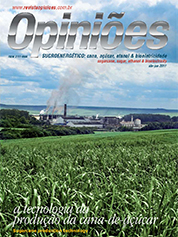João Paulo Pivetta
Manager for Sugarcane Agriculture at Bayer CropScience
Op-AA-28
Proper management contributes to the quality
According to Conab - Companhia Nacional de Abastecimento, average productivity in the country’s 2010/2011 sugarcane harvest was 77.8 tons per hectare, whereas 46.2% of total production were destined to sugar and 53.8% to ethanol. The crop is one of the oldest in Brazil, it spread throughout the country, and today occupies 8,033 hectares of land used for sugar and ethanol production.
Although it has been cultivated for so long, sugarcane has always suffered damage caused by pests such as the sugarcane borer (Diatraea sacharalis) and the sugarcane spittlebug (Mahanarva fimbriolata), both well-known in the sugarcane industry due to their widespread presence in the whole country and the visible direct and indirect losses they cause.
The borer causes the sugarcane plant to lose weight (tons/hectare), causes sucrose inversion, and contaminates the broth, causing losses of sugar and ethanol, both in quantity and quality. The intensiveness of damage caused by the spittlebug depends on factors such as the sugarcane’s development stage at the time the pest appears, population count, and the amount of time the crop is exposed to the pest.
Plantations harvested in the beginning and halfway through the season suffer less damage than those harvested at the end, given that they are more developed when the pest appears in the field. Sugarcane harvested at the end of the season, however, is little developed when the rain season begins and can therefore suffer more severe damage.
In the 90’s, due to intensive biological control and higher investments in technology, the occurrence of the borer decreased quite significantly. According to information published by CTC – Sugarcane Technology Center, as investments in biological control labs increased, attacks by the pest declined, diminishing the borer infestation rate.
In that same time period, however, still according to CTC, with the change in the harvesting system to green sugarcane, some pests, such as the spittlebug, which in a short period became a problem for the crop, found more favorable survival conditions. To minimize losses, producers must look for efficient control alternatives that warrant quality and productivity of plantations.
To manage the borer, chemical and biological control integration is a more viable alternative, given that it takes less time and costs less. However, for proper management, it is important that producers choose a selective pesticide in lieu of natural agents such as the Cotesia flavipes wasp, and that they know when it is the right time to apply the pesticide.
Before choosing the pesticide to be applied, producers must consider the product’s selectivity, so as to combine its action with that of the borer’s natural enemy. Aware of the importance of integrated management of this wasp type and of pest control, Bayer CropScience developed a physiological pesticide, a chitin synthesis inhibitor belonging to the “benzoilureia” group and known by the trade name Certero, compatible with integrated management because its differential is selectiveness, i.e., it does not affect the important natural agent (the wasp) in biological control of the borer in sugarcane plantations.
For the spittlebug, on the other hand, the quick effect of shock application in pest control is essential. The longer the pest stays in touch with the cane, the greater is damage in terms of productivity and compromising raw material quality. Pest control must be associated with sustainable management, and to prevent resistance is a basic principle to assure sustainability and production.
To directly act in controlling the spittlebug, Bayer Cropscience developed a pesticide belonging to a new chemical group (Fenilpirazol), sold under the trade name Curbix, which directly contributes to managing crop resistance. Reinfestations are quite common and vary according to climate conditions and production regions, whereas Curbix, thanks to its prolonged residual effect, performs constant control.
This is to say that even under favorable climate conditions for the pest, no variations occur, nor does the spittlebug population increase in plantations in which the product is applied. When properly used, pesticides bring about good pest control, with significant gains in terms of stalk and sugar productivity. Producers must be alert and must properly manage their crop using the instruments available, which can contribute to achieve better quality and profitability at the end of the harvest.




